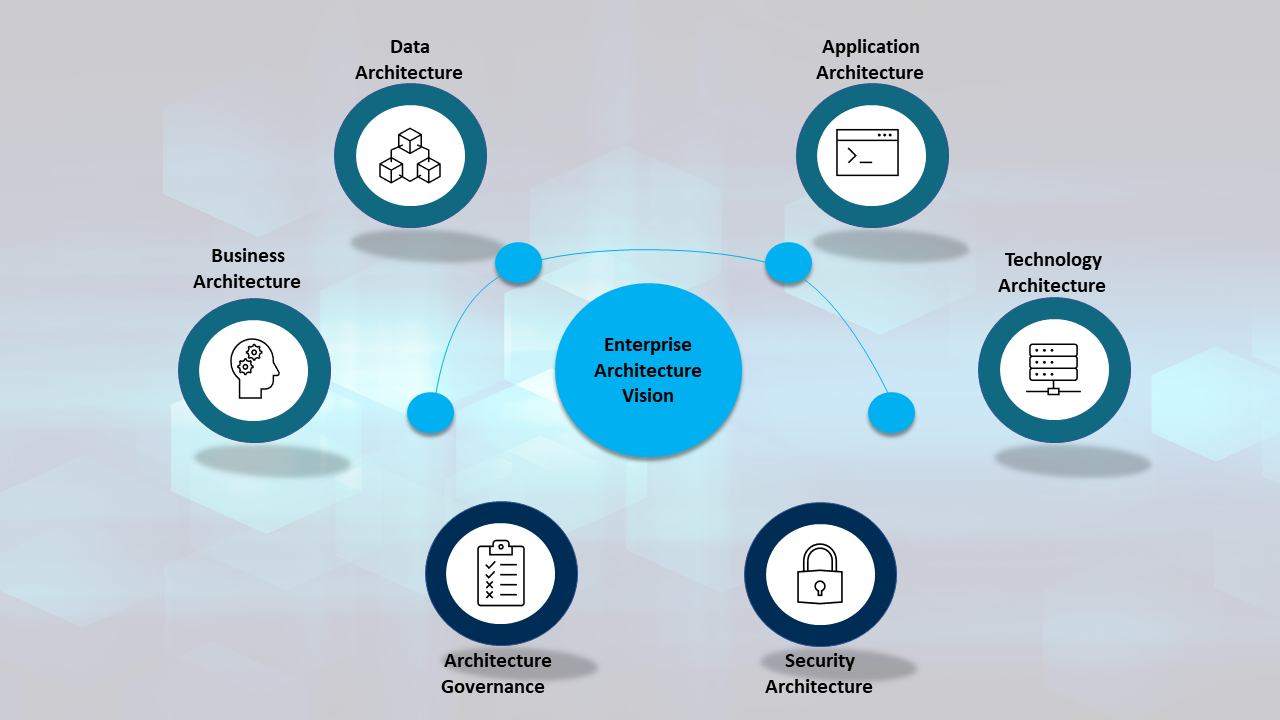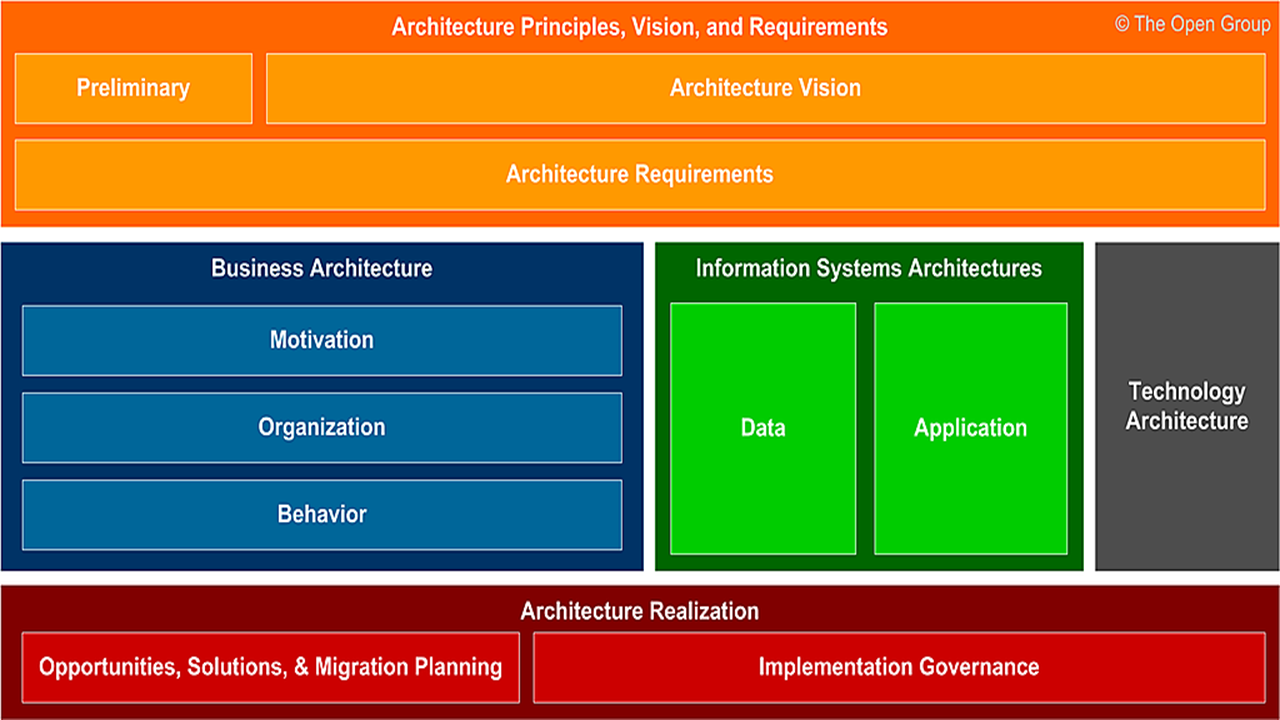Enterprise Architecture:
Helping You Develop Your Business Case
What is Enterprise Architecture?
If Enterprise Architecture (EA) were a city office for example, it would be known as the Urban Planning or Urban Design Department. This department is known for taking input from all other areas in order to scale strategically and adapt to any changes coming in the future.
Enterprise Architecture takes its input from:
- Business Architecture – this is how the organization is structured and identifies what the functional capabilities are that will be needed to deliver the business vision, strategy and objectives. It is also where the “Who” is defined to clarify ownership of the business services and capabilities.
- Application Architecture – these consist of the individual applications, how they interact, and their relationships to the organizations core business process.
- Data Architecture – this describes an organizations structure of their physical and logical data assets and data management resources. For example, the data analytics that profile your customers are used here to allow for improvement and continuous evolution of the business processes.
- Technology Architecture – this would be the area that explains what hardware and software will be needed to implement and align to the business, data and application domains. Each of these domains must have easily understood and in common language, artifacts, practices and diagrams.
Side note: For quite a while, it was always understood that we would imagine the domains above as layers, with each layer containing what components will be required to execute the processes and services to the layer above. Because of this line of thinking, many Enterprise Architect frameworks will choose to combine both the application and data layers and placing them between the business and technology layers.
Why would we use an Enterprise Architecture?
It is all about understanding the scope of Enterprise Architecture. This would include four aspects.
- The people of the organization
- The business processes of the organization
- The information technology of the organization
- The relationships of all above to one another and externally in the environment
Enterprise architecture applies principles and practices in guiding an organization through the alignment of the business, information, process, and technology domains. Achieving successful change depends on:
- Proper business and technology alignment
- Consistency in the organizational landscape
- Critical information sharing and interoperability
- Tangible ROI – return on investment
- Agility and flexibility
Major Frameworks
Without going into detail of each framework, it would be best to note the major ones to give you an idea of which ones tend to fit in to the Enterprise Architecture domain. This is not to say only the below list of frameworks are to be used. Quite the opposite, while there are main frameworks used, each organization is unique and what works for one may not for another. Given that info, many have used one framework or a combination of a few framework’s best practices to assess, align and organize business objectives to technical requirements and strategies.
- Zachman framework
- The Open Group Archive Framework (TOGAF)
- NAF
- DoDAF
- MoDAF
- Others
Breaking down an EA framework
Any architecture frameworks goal, would be to establish common practices in order to create, analyze, interpret and use proper architecture descriptions (Viewpoints and views) within a specific domain of the stakeholder community.
We would utilize an Enterprise Architecture framework to streamline the process when creating and maintaining all layers of the sub-architectures (business, application, data, technology for example).
So we’ve established that an Enterprise Architecture framework at this point, produces an output consisting of the best practices, tools standards, templates and processes to align with the strategic plan and scope defined by the organization. These outputs will typically include the following for example:
- Easily understood and common vocabulary, taxonomy and models
- Tools, strategies, principles and processes
- Reference models and architectures
- Guidance in the form of EA processes, implementation roadmap, architecture content and governance
- Catalogue of artifacts and architecture deliverables
- A Meta-model of Enterprise Architecture Content
Benefits of Enterprise Architecture to an organization
Managing complexity
Medium to large businesses often struggle to maintain a complicated setup of systems and applications each with varying degrees of prominence, importance, and relevancy to the organization.Enterprise architecture gives a top down view of the organization that would help to assess with confidence which assets are being used to maximum efficiency. As technology alone is a major burden to any budget, this framework, for example, would identify gaps and opportunities to re-align the tech stack in an organization and significantly reduce costs. Additionally, an impact analysis might uncover application/process redundancies or bring to the forefront a seemingly docile application or process that was planned to be phased out only to realize its importance is integral to the business.
Identified, supported and actionable EA deliverables
A well designed EA structure will identify gaps in an organization, leaving it in a position to make better, more informed decisions regarding investment. Of course, this also eludes to the fact that an organization not only understands why an investment is needed but also what they need to invest in.
EA will also help to identify the when an investment will be required. From here, you will have identified where the prioritization of a necessary purchase will need to be made.
Greater agility and a quicker timeline to value
In an ever-evolving era of technology, not to mention the speed of disruption and digital transformation, it is more than clear why Enterprise Architecture tools would be needed. An organization successfully using EA tools will gain a healthy understanding of the business and are better equipped to handle evaluating and implementing new technologies and processes in an efficient and timely manner.
Enterprise Architecture tools will significantly accelerate the analysis and decision support process related to rationalization, investment options and opportunities and plans for optimization. Alternatively, EA tools will also speed up risk assessment and implement change with minimal impact to the organization.
Benefits of Enterprise Architecture to an organization
Managing complexity
Medium to large businesses often struggle to maintain a complicated setup of systems and applications each with varying degrees of prominence, importance, and relevancy to the organization.Enterprise architecture gives a top down view of the organization that would help to assess with confidence which assets are being used to maximum efficiency. As technology alone is a major burden to any budget, this framework, for example, would identify gaps and opportunities to re-align the tech stack in an organization and significantly reduce costs. Additionally, an impact analysis might uncover application/process redundancies or bring to the forefront a seemingly docile application or process that was planned to be phased out only to realize its importance is integral to the business.
Identified, supported and actionable EA deliverables
A well designed EA structure will identify gaps in an organization, leaving it in a position to make better, more informed decisions regarding investment. Of course, this also eludes to the fact that an organization not only understands why an investment is needed but also what they need to invest in.
EA will also help to identify the when an investment will be required. From here, you will have identified where the prioritization of a necessary purchase will need to be made.
Greater agility and a quicker timeline to value
In an ever-evolving era of technology, not to mention the speed of disruption and digital transformation, it is more than clear why Enterprise Architecture tools would be needed. An organization successfully using EA tools will gain a healthy understanding of the business and are better equipped to handle evaluating and implementing new technologies and processes in an efficient and timely manner.
Enterprise Architecture tools will significantly accelerate the analysis and decision support process related to rationalization, investment options and opportunities and plans for optimization. Alternatively, EA tools will also speed up risk assessment and implement change with minimal impact to the organization.
Enterprise Architecture Visualization

Final Thoughts
It is important to understand that the key to developing a mature Enterprise Architecture initiative is in identifying a single source of truth, which remains consistent across the enterprise. Whether on-prem or in the cloud, access for all stakeholders in the EA environment needs to be fluid to maintain a unified, dedicated, centralized and collaborative best practice.
The EA tools used should be integrated and able to share views and information regarding business capabilities, strategy, information assets, applications, technologies etc., all to assist stakeholders in understanding the organizations enterprise overall.
Why Interfacing
The aim of Enterprise Architecture is to present the organization in terms of its business entities, properties and relationships between the external environment and themselves. Professionals at Interfacing can help you and your organization implement the right Enterprise Architecture for your industry and business. Contact us more for information.
Trial Our Enterprise Process Center as part of your Business Architecture planning for your Digital Transformation!
Document, improve, standardize, and monitor your business processes, risks and performance with Interfacing’s Enterprise Process Center®!

